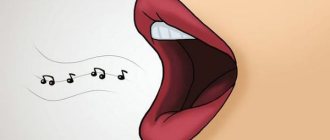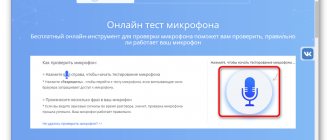Home — About speech therapy — Dysarthria – what is it?
In our daily lives, we often encounter the fact that not only children, but also some adults pronounce certain speech sounds in an unusual way, not like everyone else. Moreover, in some cases such originality in the pronunciation of sounds is expressed sharply and literally “cuts the ear,” in others it is less noticeable, but still attracts attention. People around any disorder in sound pronunciation often mistakenly call it “dysarthria.” Let's figure out what “dysarthria” is and how to overcome it.
The term “dysarthria” itself
means “disorder of articulate speech” (“artron” translated into Russian means “articulation”, and “diz” means “disorder”).
Textbooks give us this definition:
Dysarthria is a violation of sound pronunciation and prosodic components of speech, which is caused by organic damage to the central part of the speech motor analyzer and the associated disturbance of the innervation of speech muscles
.
Those. This is a severe speech disorder that is associated with brain damage. Dysarthria is usually just one of the symptoms of a serious illness - cerebral palsy.
, which most often appears before the age of 2 years or is congenital. Manifestations of dysarthria depend on the area and severity of brain damage.
Reasons
cerebral palsy, and, consequently, the causes of dysarthria are organic lesions of the child’s nervous system, which can occur in utero, during childbirth or as a result of early childhood diseases (meningitis, meningoencephalitis, traumatic lesions or vascular disorders).
There are 3 degrees of severity of dysarthric disorders:
1. Anarthria
lack of articulate speech, occurs with the most severe brain lesions; speech resembles a moo and can be incomprehensible even to the child’s loved ones.
2. Dysarthria
– slurred, incomprehensible speech, “porridge in the mouth”; There are 5 forms of dysarthria (bulbar, pseudobulbar, cerebellar, cortical, extrapyramidal).
3
.
Erased dysarthria
is the mildest degree of dysarthric disorders, which is associated with minimal brain damage (the child’s speech is understandable to others, but is replete with a large number of sound pronunciation disorders). With erased dysarthria, there are small organic lesions of the cerebral cortex, which leads to paresis of only certain groups of articulatory muscles. Then the child’s pronunciation of individual sounds is impaired when the rhythm and tempo of speech is close to normal and in the absence of obvious disorders of speech breathing and voice.
Voice disorders. Dysphonia, Aphonia, Phonosthenia.
After working with a psychiatrist, preparation for breathing work begins. If the laryngeal nerve is damaged during paralysis, then it will be almost impossible to restore its motor function. In other cases, functional training is required. The exercises will increase the mobility of the healthy part of the larynx, and in case of paralysis, they will partially restore the mobility of the vocal fold.
The next step is to normalize physiological breathing and phonation. Classes should be aimed at normalizing breathing and begin with “blowing into a harmonica.” You need to blow slowly, inhaling and exhaling on the same note. Healthy children should start training with 1 minute 10 times a day, gradually increasing the time to 2 minutes and 15 repetitions per day. If you feel dizzy, you should reduce the exercise time to 15-20 seconds.
This activity lengthens the exhalation, and the uniform movements of inhaled and exhaled air massage the larynx, thereby increasing the mobility of the healthy part of the larynx and activating the paralyzed part. In combination with “blowing into a harmonica,” breathing exercises are recommended that train extended exhalation:
Complex A. Sit straight in a chair or stand up:
1) Take a quick shallow breath and then a long exhale;
2) Inhale through your nose and exhale through your mouth;
3) Inhale through your mouth, exhale through your nose;
4) Inhale and exhale with only one half of your nose, then the other;
5) Inhale through one half of your nose and exhale through the other;
6) Inhale through your nose and then exhale slowly with increasing force at the end;
7) Inhale through your nose, exhale through loosely pursed lips;
 Inhale through your nose, exhale through your nose while holding your breath.
Inhale through your nose, exhale through your nose while holding your breath.
Do not start doing breathing practices and exercises right away so as not to overload the patient. Do breathing exercises for about a week, and then add exercises for the muscles of the neck and larynx.
Complex B. To perform the exercises described below, you need to sit up straight:
1) Place your hands in a lock at the back of your head, tilt your head back and apply slight resistance with your hands;
2) Clench your hands into a fist and rest your hands on your chin, then tilt your head forward, providing resistance with your hands;
3) Cover your ears with your palms, then tilt your head towards your shoulders with resistance from your hands;
4) Squeeze your jaws, and then move your lower jaw down, to the sides, forward;
5) Puff out your cheeks;
6) Use the tip of your tongue to reach the roof of your mouth;
7) Raise your palate when you yawn.
The above workouts are very easy to do. It is recommended to perform them 6 times during the day, repeating each approximately 5 times.
When combining exercises with a speech therapist and classes to establish diaphragmatic breathing, the reflex cough will disappear, exhalation will significantly lengthen and weak oscillatory movements of the paralyzed part of the larynx will appear. The next step is exercises for voice coordination. The essence of these exercises is that the vibrations of sound affect the mechanism of voice formation. With regular practice, the correct acoustic effect is achieved, which is what voice production consists of.
The correction begins with the pronunciation of the letter {m}, which allows you to establish the correct phonation.
Exercise 1 . Pronounce the sound slowly and briefly, directing it so that it “hits” the roof of your mouth, thereby causing resonance. After a couple of training sessions, the phonations will become longer and the voice will sound clearer. When the exercises no longer cause difficulties, proceed to the pronunciation of open syllables.
Exercise 2 . First, pronounce one sound {m}, then alternate vowels with this sound, for example: ma, mo, mu, me, we. At the same time, sharply lower your lower jaw. To consolidate the result, after a couple of lessons, you need to pronounce the syllables, with the emphasis on the second word.
Exercise 3. Pronounce the following syllables: - ma-ma na-na; - ma-mo na-no; - ma-moo na-well and so on.
Exercise 4 . Say the following syllables: mom-mama-mama; nana-nana-nanana and so on.
When the syllables sound loud and full, you can move on to the next task. Exercise 5. Say the sound {th} in combination with vowels
Repeating vowels on a hard attack has a positive effect on the closure of the vocal folds. Pronounce the vowels briefly and firmly, and the sound {th} for a long time: ay... yai..., oh... her..., uh... yu..., hey... her...
After the above activities, coordination of breathing and voice production is necessary. To achieve this, pronounce vowel sounds in one exhalation. Exercise 6 . Pronounce syllables with vowels, for example: a, ao, ay, ae, ai, aou, aoe, aoi, aouei, aoui, etc.
The child must repeat the syllables, first after the speech therapist, then independently.
Pronouncing the combinations easily and without complaints, you can move on to the next stages of treatment - working on the restored voice. To work it out, the following syllables are rehearsed: ma, mo, mu, me, we. Gradually starting phrasal speech and reading.
When working with speech material, it is recommended to practice vocals. Exercises will help strengthen your voice and increase sonority. You can sing triads, melodies without sharp transitions or scales.
When the voice is restored, it sounds loud, accompanied by organized breathing, and there is no unpleasant sensation in the throat. During the examination, the vocal folds close, and their vibrations are visible on the affected part of the larynx.
The duration of rehabilitation work lasts up to 4 months, the duration of treatment depends on the severity of the disorder and the time of start of classes.
GBOU "NIKIO im. L.I. Sverzhevsky" of the Moscow Department of Health
Functional dysphonia is a violation of vocal function, characterized by a violation of the closure of the vocal cords in the absence of pathological changes in the larynx.
The causes of a functional voice disorder can be constitutional, anatomical, congenital features of the vocal apparatus, voice overstrain, traumatic factors, previous respiratory diseases, asthenic syndrome of any etiology. Hypotonic disorders can also develop against the background of prolonged silence, as well as after surgical interventions on the larynx or with atrophy of the vocal folds. Anxiety and depressive disorders can contribute to the development of functional dysphonia. Hormonal disorders, most often thyroid diseases, play a significant role in the occurrence of functional dysphonia. Other causes are neurological diseases such as Parkinson's disease and myasthenia gravis, traumatic brain injury, cerebrovascular accident, etc.
Functional changes are reversible, but in some cases they can lead to organic changes in the larynx.
The clinical picture of functional dysphonia is caused by a violation of the vocal function of varying degrees of severity.
Hypotonic dysphonia is a violation of vocal function caused by a decrease in the tone of the vocal folds and other muscles involved in voicing. Rapid voice fatigue and aspirated hoarseness are noted.
Hypertonic dysphonia is a violation of vocal function caused by increased tone of the vocal folds. Phonation is carried out with tension in the neck muscles, the voice is sharp, and hoarseness is pronounced.
Hypo-hypertonic dysphonia (vestibular-fold voice) is a violation of vocal function due to a decrease in the tone of the vocal folds with the formation of phonation at the level of the vestibular folds with the subsequent development of their hypertrophy.
Aphonia is the lack of sonority of the voice while maintaining whispered speech.
Psychogenic dysphonia or aphonia is a disorder of vocal function, the leading etiological factor of which is considered psychogenic.
Mutational dysphonia is a voice disorder that occurs during the period of mutation.
Spasmodic dysphonia is a voice disorder characterized by tense and compressed intermittent phonation, tremors, hoarseness, and impaired speech intelligibility. There are abductor and adductor forms. During speech, twitching of the diaphragm is noted. Articulation disorders and changes in the psycho-emotional sphere are diagnosed. Clinical and neurological examination reveals organic pathology in the form of dystonic syndromes (such as writer's and blepharospasm, torticollis, etc.).
In the process of diagnosing and treating voice function disorders, a multidisciplinary approach is required with the involvement of a neurologist, endocrinologist, psychiatrist and phonopedist in the rehabilitation process.
Treatment of functional dysphonia
The approach to the treatment of functional dysphonia should be comprehensive. It is necessary to influence etiopathogenetic factors: treatment of general somatic diseases, somatomorphic disorders, sanitation of foci of chronic infection.
The prognosis for functional dysphonia is often favorable. Persistent impairment of vocal function and a long-term course lead to a deterioration in the patient’s communication.
Prevention of vocal function disorders consists, first of all, in maintaining vocal hygiene, developing correct phonation skills, and developing the speaking and singing voice, especially in people of voice-speech professions. Timely diagnosis and treatment of general somatic diseases leading to the development of dysphonia are of great importance.
Treatment
A course of phonopedic classes with a phonopedist is aimed at restoring the tone of the vocal folds and removing “clamps” from the larynx. A phonopedic therapist helps to understand the causes of incorrect voice guidance, develop a personal course of phonopedia, and restore voice function. This comprehensive approach allows you to restore your voice and prevent recurrence of laryngeal disease in the future.
We should not forget that ignoring a problem with the voice will lead to the consolidation of incorrect phonation, deterioration of vocal function, and may become the beginning of the emergence of organic pathology of the vocal apparatus - laryngitis, laryngeal tumors.
Voice formation is a complex and multi-level process. The “primary” tone that arises at the level of the vocal part of the larynx, passing through the resonators, acquires an “extravocal” timbre that is unique for every adult. This explains how great the influence of the condition of the respiratory tract (AP; upper and lower) is on voice quality. The role of the endocrine system cannot be ignored. When stressed and fearful, the adrenal glands release chemicals: adrenaline and norepinephrine, an increase in the level of which causes tachycardia, increased blood pressure, sweaty palms, dry mouth, respiratory tension, nausea, and sometimes involuntary urination. The combination of these symptoms makes up a well-known phenomenon - fear of the public. Changes in voice quality (narrowing of range, monotony) with hyper/hypothyroidism have been repeatedly described. Malfunctions in the digestive system can lead to changes in the structures of the larynx, for example, to damage to its mucous membrane by the acidic components of gastric juice in gastroesophageal reflux disease (GERD) [1].
The development and formation of a child’s voice is closely related not only to changes in individual systems, but also to the growth of the entire organism, as well as the development of the articulatory apparatus. The voice is directly interconnected with both speech and hearing, with the help of which a person not only perceives the speech of others, but also controls his own.
In this regard, the cause of voice changes/impairments can be many different conditions and diseases, both isolated and in various combinations [1]. For example, disturbances in voice timbre (dysphonia/aphonia) can be considered as manifestations of organic or functional disorders on the part of the anatomical elements of the peripheral part of the larynx, the neuromuscular system, nerve pathways (afferent and efferent) or various parts of the central nervous system, directly or indirectly involved in the implementation of the process of voice formation/voice leading. Environmental conditions also influence voice quality [2].
Taking into account the variety of causes that cause voice disorders, a wide arsenal of drugs can be used to relieve the conditions and diseases that cause them, as well as restore a normal sonorous voice.
Within the framework of this article, I would like to dwell on disturbances in voice timbre and the impact of drugs on voice quality, because Often this aspect of their action is not taken into account when conducting clinical trials and prescribing therapy by practicing physicians. In the instructions for use of drugs (and in special medical literature), when listing side effects, voice disorders are extremely rarely mentioned. Changes in the manner of voice production have been described when using local anesthetics (irrigation of the laryngeal mucosa), as well as dysphonia due to the use of inhaled forms of drugs, such as corticosteroids.
In this regard, I would like to recall the influence of various groups of drugs on voice quality. These data are presented schematically in Table. 1. It is also possible that there is an indirect effect of drugs (for example, atropine, dopamine, nicotine, calcium channel blockers, sedatives, nitrates, theophylline and adrenergic agonists), which can lead to the development of GERD, in which the laryngeal structures and voice quality suffer (see above) . Treatment of GERD includes antacids, histamine receptor blockers, proton pump inhibitors, which, in addition to their positive effects, also have side effects (the development of diarrhea, abdominal pain, nausea and vomiting) that negatively affect performance, voice and speech.
Separately, I would like to dwell on herbal preparations, the popularity of which is constantly growing. Not all of them are drugs; many of these drugs are registered as biologically active additives (BAA). Manufacturers of dietary supplements are not allowed to declare their products as means for the treatment and prevention of diseases, but they advertise them as immunostimulants, drugs for weight loss, increasing stamina, stimulating vital functions, combating fatigue, improving memory, elevating mood, combating osteoporosis and etc. Insufficient awareness of the population not only about the effects of dietary supplements, but also about their interactions with simultaneously taken drugs can lead to serious negative consequences, even death. According to ordinary people, herbal preparations contain only natural substances and for this reason cannot have a harmful effect on health. This opinion can be justified only if these drugs are used in moderate quantities and if there are guarantees from the manufacturer, but the production of dietary supplements (considered food additives) is not regulated as strictly as the production of drugs. Herbal components may have side effects (Table 2), incl. as serious as hallucinations and coronary events.
The use of naturopathic drugs can be a worthy alternative to dietary supplements. This group includes homotoxicological, phytoniring and homeopathic drugs, the production of which is strictly regulated. For the population, in most cases, homeopathic medicines (HPPs) are identified with natural treatment; There is an opinion that these are drugs for children with allergies to allopathic drugs. The use of classic GPP requires special knowledge and skills from the doctor; in addition, specialized pharmacies are not available everywhere. At the same time, many active components of the GLP are capable of influencing various levels of the process of voice formation and voice production (Table 3).
The use of complex GPPs is interesting because they can be used by everyone, because are produced in the form familiar to most patients (tablets, drops, syrups), have clear instructions for use with verified single, daily and course dosages. Today, practically the only drug that has official indications for use for various voice disorders, which can be used for various inflammatory diseases of the larynx, is GPP Homeovox (Boiron Laboratory, France). It contains components such as Aconitum napellus (monkshood), Arum tryphyllum (Arisema trifolia), Ferrum phosphoricum (iron phosphate), Calendula officinalis (calendula), Spongia tosta (burnt sponge), Atropa belladonna (belladonna), Mercurius solubilis (mercury soluble according to Hahnemann), Hepar sulfur (lime sulfur liver according to Hahnemann), Kalii bichromicum (potassium bichromate), Populus candicans (poplar), Bryonia dioica (dioica).
The effectiveness of the drug Gomeovox was assessed in numerous comprehensive studies [3–23] conducted both abroad and in Russia. At the same time, the properties of the drug were studied most deeply by domestic authors [14–23]. The use of Homeovox for therapeutic purposes has been described in children and adolescents with functional (including mutational) dysphonia [14, 16, 19, 21], with various forms of laryngitis (acute non-obstructive [15, 17, 18, 20, 23] and chronic [16, 17, 20]), in patients diagnosed with vocal fold nodules [16, 17]; as well as its therapeutic and prophylactic use (in combination with antiviral drugs) in patients with dysphonia that persists after suffering recurrent obstructive laryngitis (“false croup”) [19].
Despite the fact that the mechanism of action of homeopathic remedies has not been studied in detail, both doctors and patients/their legal representatives note an improvement in voice quality (sonority, sonority) already in the first days of taking the drug Homeovox - even before the endolaryngoscopy picture begins to normalize (Fig. 1–3 ).
The question of the dosage of Homeovox is relevant. The minimum dose is 10 tablets per day (2 tablets 5 times a day, dissolve between meals). The starting therapeutic dose is 2 tablets every hour, regardless of age; as the condition improves, the interval between doses of the drug can be increased with a gradual transition to the minimum maintenance (preventive) dose. Individual selection of a prophylactic dose in the maximum-minimum range is possible. Another important aspect of the use of Homeovox is age restrictions. Having appeared on the Russian pharmaceutical market, the drug had no age restrictions [24], but currently it is allowed to be used by patients older than 1 year [25].
The causes of dysphonia are not limited to those described above, therefore an endoscopic examination of the larynx is mandatory even in the case of short-term/one-time hoarseness.
Diagnosis of hypotonic dysphonia
When examining a patient, a phoniatrist sees during phonation a glottis of different sizes and locations - in the middle, posterior parts of the vocal folds, or even along the entire length. This means that the vocal folds do not close together. And because of this, the air does not linger in the subglottic space, a full-fledged strong voice is not formed, the voice is weak, the voice is quiet, the voice trembles when singing, it is impossible to talk for a long time. The severity of hoarseness may vary, the strength of the voice decreases, vocal fatigue appears, and the timbre changes. This makes it difficult for vocal educators, teachers, coaches, the training of future singers, and the performance of professional duties for everyone.
Causes of hypotonic dysphonia
The reasons for this type of voice disorder are different. The most common is VSD, the so-called vegetative-vascular dystonia, incorrect vocal technique, vocal stress, osteochondrosis, hypothyroidism. Therefore, it is necessary to look for the cause of the formation of hypotonic dysphonia. After determining the cause of the disease, the doctor will prescribe individual treatment, including drug therapy, physical therapy and pedagogical correction. Teachers, i.e. phonopedists work very seriously on voice correction as part of the treatment process.
Speech and non-speech symptoms of dysarthria
Speech symptoms
:
1) Violation of voice formation.
2) Violation of sound pronunciation (almost all groups of sounds). Depending on the degree of damage, the pronunciation of all or several consonants may be affected. The pronunciation of vowel sounds may also be impaired (they are pronounced unclearly, distorted, often with a nasal tint).
3) The so-called speech prosody suffers (a set of rhythmic and intonation means of speech), including: timbre (dull, hoarse, monotonous, compressed, dull; can be guttural, forced, tense, intermittent, etc.); voice strength; pace; pause; rhythm; modulation (the child cannot arbitrarily change the pitch); logical stress; speech breathing; intonation; emotional coloring; flight of voice; diction and general melody of speech. It is the prosodic components that determine the expressiveness, intelligibility of speech, and its emotional impact in the process of communication.
4) Impaired perception of phonemes (sounds) and their discrimination. It occurs as a result of unclear, blurred speech, which does not allow the formation of a correct auditory image of sound.
5) Violation of the grammatical structure of speech and poor vocabulary.
Non-speech symptoms.
Dysarthria is characterized by the presence of non-speech symptoms to varying degrees, complicating the process of speech acquisition:
1. Paresis and paralysis of the muscles of the trunk and limbs, speech muscles
. Due to paresis, the child is severely or completely limited in movement, which leads to a violation of visual-spatial representation, since children perceive space “by the measure of their own steps”; paresis of the speech muscles interferes with the normal pronunciation of sounds.
2. Impaired cognitive activity:
due to limitations caused by paresis and paralysis of the hands, the child cannot fully engage in knowledge of the surrounding world, because holding objects in his hands, bringing them to his mouth, trying to “taste”, the child gains understanding about surfaces (smooth, rough), shapes, sizes, temperature (cold, warm), etc.
If the child does not gain an understanding of the various characteristics of objects (spatial, textured, etc.), this will cause difficulties in indicating these characteristics in words. Those. The child will not be able to tell on his own whether an object is further away or closer to him, which object is lower, which is higher, etc.
Paresis of the extraocular muscles also leads to a delay in the development of a child’s cognitive activity. In cases of this type of paresis, functions such as stopping the gaze on an object, “studying” it with the gaze, “tracking” a moving object, and quickly searching for an object with the eyes are disrupted. This can develop into specific impairments in writing and reading, and difficulties in mastering drawing, geometry, geography, drawing, and other subjects.
3. Emotional-volitional disorders
, depending on the area and time of brain damage, has varying degrees of severity and features of manifestation
4.Secondary mental layers
. Usually associated with the child’s feelings about his inferiority.
All these symptoms have an additional negative impact on the state of the child’s speech and the progress and effectiveness of correctional work with him.








